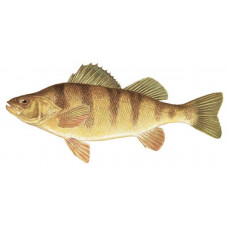Latin name
Perca flavescens
Other names
Ringed perch, striped perch, coon perch, jack perch, lake perch, American perch; French: perchaude.
Identification
Unlike the white perch, which is actually a temperate perch, the yellow perch is a true perch. Although it looks very much like a true perch, it is more closely related to other members of the Percidae family, the walleye and the sauger. Its most striking characteristic is its colorful golden yellow body, tinted by the orange color of its fins. The yellow perch is green to yellow-gold in color with six to eight dark, broad vertical stripes running from the back to the lateral line, a whitish belly, and orange lower fins during the breeding season. The body is elongated and appears hunched. This is the result of the deepest part of the body starting at the first dorsal fin and then narrowing slightly to the beginning of the second dorsal fin. This feature is somewhat similar to that of the white perch, to which the yellow perch is not related, although both fish may live in the same waters. Yellow perch differs from trout and salmon by the absence of the adipose fin, which is usually located between the dorsal and caudal fins, and from sunfish by having separate dorsal fins (sunfish have joined dorsal fins) and two or fewer spines on the anal fin (sunfish have three or more). It differs from walleye and sauger by the absence of fangs and a deeper body shape.
Distribution
Yellow perch are widespread throughout the northern United States and Canada. They are found east from Nova Scotia to the Santee River in South Carolina and west from the Great Lakes states to the edge of British Columbia and Washington. Small numbers are found north of Great Slave Lake almost to Great Bear Lake in Canada's Northwest Territories. Due to stocking, they are found in almost every state, but they are scarce in the South, much of the West and Midwest, as well as British Columbia and northern Canada. Although yellow perch are a freshwater fish, fisheries officials in Nova Scotia report that they are sometimes found in brackish water along the Atlantic coast.
Habitat
Yellow perch are found in a variety of warm and cool habitats over a wide area, although they are mostly lake fish. They are occasionally found in ponds and rivers. They are most abundant in clean, weedy lakes with muddy, sandy, or gravelly bottoms. In small lakes and ponds, the fish are usually smaller, although in very fertile lakes with moderate fishing pressure, yellow perch can grow large. They live in the open areas of most lakes and prefer temperatures in the mid-60s to low 70s.
Size
The average yellow perch caught by anglers weighs 1⁄4 to 3⁄4 pounds and is 6 to 10 inches long. In lakes with small populations, the fish are at the lower end of this range, and 10-inch fish are usually considered quite large. Bass weighing 1 pound or more are found in some lakes, although fish over 11⁄2 pounds are rare. The record yellow perch caught on all tackle in 1865 weighed 4 pounds 3 ounces and is the oldest record among freshwater sport fish. Yellow perch can grow to 16 inches and live to 12 years.
Life history and Behavior
Yellow perch usually spawn in early spring when water temperatures are between 45°F and 50°F. Eggs are hatched by the adult female in shallow lakes or upstream tributaries in gelatinous ribbons and fertilized by a dozen males in weedy areas a few feet deep. The ribbons, which can be up to 7 feet long and several inches wide, cling to vegetation until a quarter to half of the 10,000 to 48,000 eggs hatch into fry 10 days to 3 weeks after spawning. Yellow perch move in schools of fish of similar size and age, and there is some evidence that the sexes separate into separate schools. In large lakes, adults move in schools farther from the shore than do juveniles. They move between deeper and shallower water in response to changes in food supply, time of year, and temperature. Because of their predatory nature and rapid reproduction, overpopulation is a problem in many lakes where yellow perch have been introduced. The fish may become stunted and other species may be negatively affected. The introduction of yellow perch, either naturally or artificially, into trout-containing reservoirs usually results in a reduction in the trout population, and this may be true of other fish species that were dominant prior to the introduction of yellow perch.
Food and feeding habits
Juvenile yellow perch feed on zooplankton until they reach a few inches in length, at which time they feed on larger zooplankton, insects, juvenile crayfish, snails, aquatic insects, fish eggs, and small fish, including the young of their own species.
Reproduction
No information
Interesting Facts
Daytime hunters like the Yellow perch don't have the strongest sense of smell, but they can still pick up scents. A Yellow perch might ignore a bare fishing jig, but if you put a worm or a piece of fish on the hook, it'll come swimming from a distance.
| Classification | |
| Phylum | Chordata |
| Class | Actinopterygii |
| Squad | Perciformes |
| Family | Percidae |
| Genus | Perca |
| Species | P. flavescens |
| Features | |
| Conservation status | Least Concern |
| Habitat | Littoral |
| Life span, years | 12 |
| Maximum body weight, kg | 1.9 |
| Maximum length, cm | 46 |
| Sailing speed, m/s | No information |
| Threat to people | Edible |
| Way of eating | Predator |



